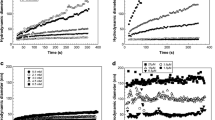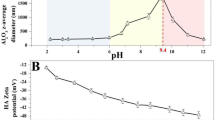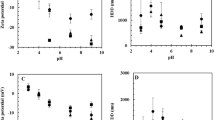Abstract
Metal oxide nanoparticles (NPs) are receiving increasing attention due to their increased industrial production and potential hazardous effect. The process of aggregation plays a key role in the fate of NPs in the environment and the resultant health risk. The aggregation of commercial titanium dioxide NP powder (25 nm) was investigated with various environmentally relevant solution chemistries containing different concentrations of monovalent (Na+, K+) and divalent (Ca2+) electrolytes. Titanium dioxide particle size increased with the increase in ion concentration. The stability of titanium dioxide also depended on the ionic composition. Titanium dioxide aggregated to a higher degree in the presence of divalent cations than monovalent ones. The attachment efficiency of NPs was constructed through aggregation kinetics data, from which the critical coagulation concentrations for the various electrolytes are determined (80, 19, and 1 meq/L for Na+, K+, and Ca2+, respectively). Our results suggest that titanium dioxide NP powders are relatively unstable in water and could easily be removed by adding multivalent cations so hazardous potentials decrease in aquatic environment.







Similar content being viewed by others
References
Adams LK, Lyon DY, Alvarez PJJ (2006) Comparative eco-toxicity of nanoscale TiO2, SiO2, and ZnO water suspensions. Water Res 40(19):3527–3532
Chen KL, Elimelech M (2006) Aggregation and deposition kinetics of fullerene (C-60) nanoparticles. Langmuir 22(26):10994–11001
Chen KL, Elimelech M (2007) Influence of humic acid on the aggregation kinetics of fullerene (C-60) nanoparticles in monovalent and divalent electrolyte solutions. J Colloid Interface Sci 309(1):126–134
Chen KL, Mylon SE, Elimelech M (2006) Aggregation kinetics of alginate-coated hematite nanoparticles in monovalent and divalent electrolytes. Environ Sci Technol 40(5):1516–1523
Domingos RF, Baalousha MA, Ju-Nam Y, Reid MM, Tufenkji N, Lead JR, Leppard GG, Wilkinson KJ (2009) Characterizing manufactured nanoparticles in the environment: multimethod determination of particle sizes. Environ Sci Technol 43(19):7277–7284
Dunphy Guzman KA, Finnegan MP, Banfield JF (2006) Influence of surface potential on aggregation and transport of titania nanoparticles. Environ Sci Technol 40(24):7688–7693
Elimelech M, Gregory J, Jia X, Williams RA (1998) Particle deposition and aggregation—measurement, modelling and simulation. Elsevier, Amsterdam
French RA, Jacobson AR, Kim B, Isley SL, Penn RL, Baveye PC (2009) Influence of ionic strength, pH, and cation valence on aggregation kinetics of titanium dioxide nanoparticles. Environ Sci Technol 43(5):1354–1359
Gao J, Youn S, Hovsepyan A, Llaneza VnL, Wang Y, Bitton G, Bonzongo J-CJ (2009) Dispersion and toxicity of selected manufactured nanomaterials in natural river water samples: effects of water chemical composition. Environ Sci Technol 43(9):3322–3328
Handy R, von der Kammer F, Lead J, Hassellöv M, Owen R, Crane M (2008) The ecotoxicology and chemistry of manufactured nanoparticles. Ecotoxicology 17(4):287–314
Hiemenz P, Rajagopalan R (1997) Principles of colloid and surface chemistry. Marcel Dekker, New York
Kosmulski M (2002) The significance of the difference in the point of zero charge between rutile and anatase. Adv Colloid Interface Sci 99(3):255–264
Marion GM, Babcock KL (1976) Predicting specific conductance and salt concentration in dilute aqueous-solutions. Soil Sci 122(4):181–187
Mchedlov-Petrossyan NO, Klochkov VK, Andrievsky GV (1997) Colloidal dispersions of fullerene C-60 in water: some properties and regularities of coagulation by electrolytes. J Chem Soc Faraday Trans 93(24):4343–4346
Mueller NC, Nowack B (2008) Exposure modeling of engineered nanoparticles in the environment. Environ Sci Technol 42(12):4447–4453
Nowack B, Bucheli TD (2007) Occurrence, behavior and effects of nanoparticles in the environment. Environ Pollut 150(1):5–22
Oberdörster E (2004) Manufactured nanomaterials (fullerenes, C60) induce oxidative stress in the brain of juvenile largemouth bass. Environ Health Perspect 112(10):1058–1062
Phenrat T, Saleh N, Sirk K, Kim H-J, Tilton R, Lowry G (2008) Stabilization of aqueous nanoscale zerovalent iron dispersions by anionic polyelectrolytes: adsorbed anionic polyelectrolyte layer properties and their effect on aggregation and sedimentation. J Nanopart Res 10(5):795–814
Research L (2008) Sizing nanotechnology’s value chain. New York
Saleh N, Kim H-J, Phenrat T, Matyjaszewski K, Tilton RD, Lowry GV (2008a) Ionic strength and composition affect the mobility of surface-modified Fe0 nanoparticles in water-saturated sand columns. Environ Sci Technol 42(9):3349–3355
Saleh NB, Pfefferle LD, Elimelech M (2008b) Aggregation kinetics of multiwalled carbon nanotubes in aquatic systems: measurements and environmental implications. Environ Sci Technol 42(21):7963–7969
Sano M, Okamura J, Shinkai S (2001) Colloidal nature of single-walled carbon nanotubes in electrolyte solution: the Schulze−Hardy rule. Langmuir 17(22):7172–7173
Shih Y-h, Tso C-p (2012) Aggregation and disaggregation of three selected metal oxide nanoparticle powders in water. Coll Surf A (In review)
Tso CP, Zhung CM, Shih YH, Tseng YM, Wu SC, Doong RA (2010) Stability of metal oxide nanoparticles in aqueous solutions. Water Sci Technol 61(1):127–133
Yaremko ZM, Tkachenko NH, Bellmann C, Pich A (2006) Redispergation of TiO2 particles in aqueous solutions. J Colloid Interface Sci 296(2):565–571
Zhang Y, Chen Y, Westerhoff P, Crittenden JC (2008a) Stability and removal of water soluble CdTe quantum dots in water. Environ Sci Technol 42(1):321–325
Zhang Y, Chen Y, Westerhoff P, Hristovski K, Crittenden JC (2008b) Stability of commercial metal oxide nanoparticles in water. Water Res 42(8–9):2204–2212
Acknowledgments
The authors thank Environmental Protection Administration (EPA), Taiwan for the financial support under Contract No. EPA-97-U1U1-02-104. The authors would also send their gratitude to Prof. Shian-chee Wu, Prof. Ruey-an Doong, Dr. Gwo-Dong Roam (Taiwan EPA), and Desiree L. Plata (Duke U. in USA) for their valuable comments on this study.
Author information
Authors and Affiliations
Corresponding author
Rights and permissions
About this article
Cite this article
Shih, Yh., Zhuang, Cm., Tso, Cp. et al. The effect of electrolytes on the aggregation kinetics of titanium dioxide nanoparticle aggregates. J Nanopart Res 14, 924 (2012). https://doi.org/10.1007/s11051-012-0924-3
Received:
Accepted:
Published:
DOI: https://doi.org/10.1007/s11051-012-0924-3




